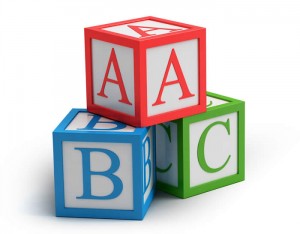The Dawn of wLearning and the Full Alphabet of Learning
For over a decade we’ve explored the world of eLearning, and all the possibilities technology opens up for learning. In recent years we’ve also started exploring mLearning, and how mobile technologies can be used to enhance learning and performance support. Those terms – eLearning and mLearning – are part of the vernacular of the learning and performance profession.
With the Apple Watch almost upon us, we approach the next logical milestone in learning – the dawn of watch-based learning, or wLearning. Don’t let the small screen size fool you – there’s a whole lot of content that can be packed into that small square touchscreen. And taptic feedback? Imagine a Next button that taps you back. The possibilities are endless.
 But why should we stop at wLearning? For that matter, Why are we already talking about wLearning? It seems we have skipped many valuable letters to apply towards learning approaches. And I consider that to be a lost opportunity.
But why should we stop at wLearning? For that matter, Why are we already talking about wLearning? It seems we have skipped many valuable letters to apply towards learning approaches. And I consider that to be a lost opportunity.
So let’s fix that. Here are the remaining 24 types of learning we should add to our profession’s vernacular.
- aLearning: This is the catch all that applies to all learning. It fits nicely into our vernacular already. “He learned how to complete that task by going through aLearning.”
- bLearning: All learning programs are not created equal; some can be downright silly and cheesy. Much like a b-movie, bLearning embraces these traits as a badge of honor.
- cLearning: We often talk about the value learning adds to an organization. cLearning focuses on making learning visible so that everyone can “see” it’s value.
- dLearning: Much as devaluing something reduces it’s value, dLearning reduces the effectiveness of learning programs. This approach works well in organizations that value information hoarding.
- fLearning: This applies to individuals and organizations that have a, well, let’s call it “less than enthusiastic” view on learning.
- gLearning: Games are great for learning. So great in fact, that game-based learning deserves it’s own category.
- hLearning: Sometimes learning programs are so good, they catch us by surprise. Learning programs that give individuals that “Holy $#!+!” feel fall under the heading of hLearning.
- iLearning: Music. SmartPhones. Watches. Apple continues to inch it’s way towards global domination. Learning is next.
- jLearning: Just in time, just in case… “just” is big in learning vernacular. Well sometimes you just want to talk about learning without over-complicating it. When you just want learning, you need jLearning.
- kLearning: In baseball a “k” represents a strikeout; something that removes a batter as a potential impact in the game. kLearning programs are lean by design, focusing on “striking out” extraneous content that distracts from the objectives.
- lLearning: Laughter is the best medicine, right? Well lLearning focuses on laughter, and making sure that learning programs focus on being funny first.
- nLearning: Is your learning program so engaging that people leave mentally and physically exhausted? Perhaps it qualifies as the most engaging type of learning – nLearning!
- oLearning: We’re often so focused on delivering content that we forget that people need to absorb and contextualize it. Learning programs that are overly bloated and amount to a content dump can be classified as oLearning, as in “Oh… it’s supposed to be about learning.”
- pLearning: Learning that is so engaging, individuals forget that they need to use the bathroom.
- qLearning: Learning is often criticized for being too test-focused. qLearning laughs in the face of this criticism, being solely based on quizzes and questions.
- rLearning: The use of credible Research-based learning methodologies in learning programs is classified as rLearning. This should not be confused with the equally popular and fingerquote-centric classification of “r”Learning.
- sLearning: Learning has historically been seen as a linear experience, but we’re increasingly aware of the twists and turns that take place along the way, as learning snakes it way around a topic. Those twists and turns look more like an S than any other letter, hence sLearning.
- tLearning: Does the idea of training and learning as two different concepts make your head spin? Well, worry no more as learning via training now has it’s own designation: tLearning!
- uLearning: Learning is personal. It’s not about what I teach, it’s about what YOU learn. If the learning program is focused on someone, make it personal by co-opting the pronoun and leveraging uLearning.
- vLearning: Exaggeration. We all do it. If something doesn’t sound important enough, we add an adjective to the front to make it sound bigger. “that movie wasn’t just good, it was VERY good.” If your learning programs isn’t just good, but VERY good, it’s probably vLearning.
- xLearning: xLearning resides at the intersection of work-based learning and NSFW content.
- yLearning: Ever been through a learning program and thought “WHY did I have to take this training?” That’s yLearning.
- zLearning: Learning is sometimes criticized as boring and something that puts individuals to sleep. Well, what if putting people to sleep was the goal? (it could happen) If sleep is the learning objective, consider using a zLearning approach.
And oh yeah… Happy April Fools’ Day everyone. :-)

Leave a Reply